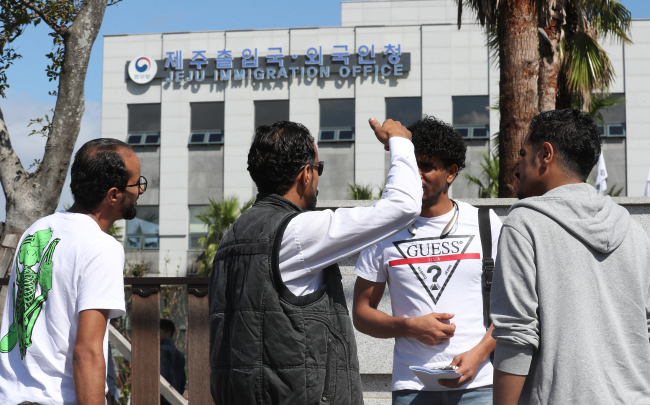The cumulative number of asylum applications filed in South Korea topped 70,000, government data showed Monday, amid persistent calls for improvements to the country’s refugee screening system.
According to data from the Korea Immigration Service, 70,254 foreigners had applied for refugee status here as of August, since the government began to compile relevant data in 1994.
The number of refugee applications soared in 2013 when the Refugee Act took effect, making Korea the first Asian country with legislation in place to address the needs of refugees, the data showed.
The combined number of refugee applications totaled 5,069 between 1994 and 2012, but skyrocketed to 1,574 in 2013, 9,942 in 2017, 16,173 in 2018 and 15,452 last year.
From January to August this year, the number of refugee applications was 5,896, down 36.5 percent from the same period a year prior. This comes as the number of foreigners entering Korea plunged by 80.6 percent during the same period, compared with the previous year.
The number of asylum-seekers granted refugee status here has fallen to a record low this year.
During the January-August period, only 41 out of 4,019 asylum-seekers, about 1 percent, received refugee status. Another 123 people were granted humanitarian stay permits.
During the eight-month period the combined proportion of those granted refugee status or humanitarian protection was 4.1 percent of all asylum-seekers, hitting an all-time low since the country began to compile relevant data in 1994. The rate was 6.1 percent last year and 16.4 percent in 2018.
Humanitarian status is granted to those who do not meet the criteria for refugee status yet whose lives are at risk in their home countries due to emergency situations such as war. The permits allow them to work and live in Korea until it is safe for them to return, and can be extended on a yearly basis.
The drop in the refugee acceptance rate could be because of a rise in refugee applications by those trapped in the country due to suspended international flights or because of refugee screening applications not being accepted and processed at usual levels amid the COVID-19 pandemic, activists say.
The refugee office at the Seoul Immigration Office, for example, only accepted 50 visitors a day as of April.
While the government remains concerned about the increase in what it sees as “fake refugees” -- those abusing the refugee system to seek economic opportunities -- activists say there is a long road ahead for Korea to guarantee rights and proper protection for asylum-seekers.
Criticism from activists centers on procedural flaws in the refugee screening process and its protracted time frame, stemming from a shortage of specialized personnel and a prejudice that most of those seeking asylum are economic migrants.
“The current refugee system led to depriving asylum-seekers of their rights to being fairly considered for refugee status and prolonging their lives here without proper rights protection,” said Koh Eun-ji, an activist with the Nancen Refugee Rights Center.
“With the number of asylum-seekers topping 70,000, we hope that the government draws up ways not only to rapidly process refugee applications but also to make them more independent, professional and transparent,” she said, referring to the discovery that some immigration officials rigged the asylum screening process between 2015 and 2018, unjustly dismissing many cases.
Last month, the National Human Rights Commission of Korea confirmed allegations that refugee application interviews had been falsified under the Justice Ministry’s “speedy” refugee screening system. The system was put in place in 2014 to shorten the screening process amid a soaring number of asylum applications and criticism that the process was dragging on for too long.
By Ock Hyun-ju (
laeticia.ock@heraldcorp.com)








![[Today’s K-pop] Blackpink’s Jennie, Lisa invited to Coachella as solo acts](http://res.heraldm.com/phpwas/restmb_idxmake.php?idx=644&simg=/content/image/2024/11/21/20241121050099_0.jpg)